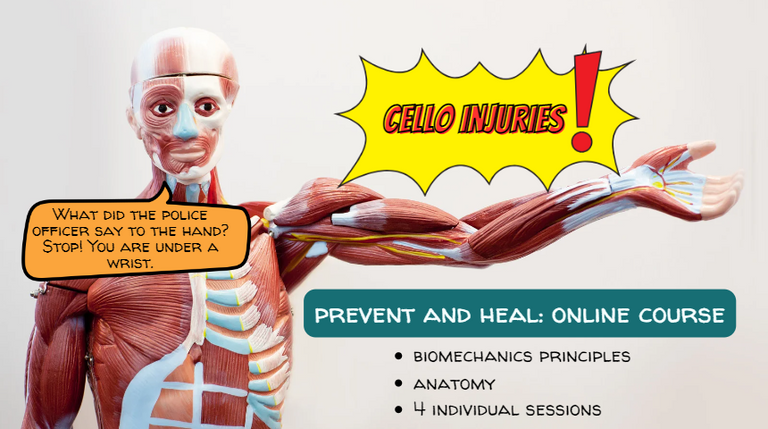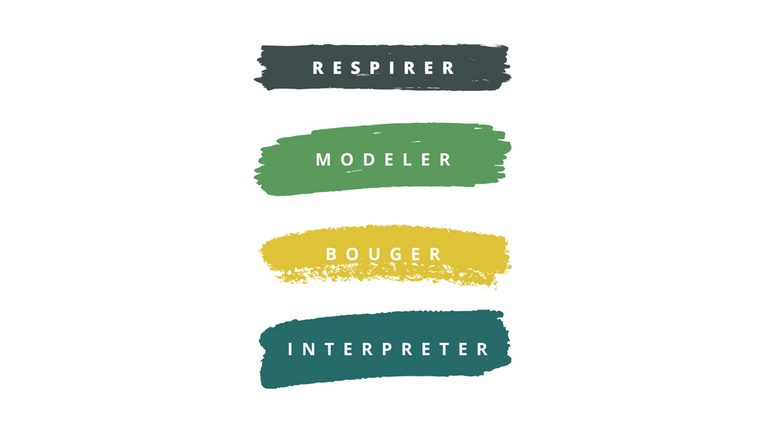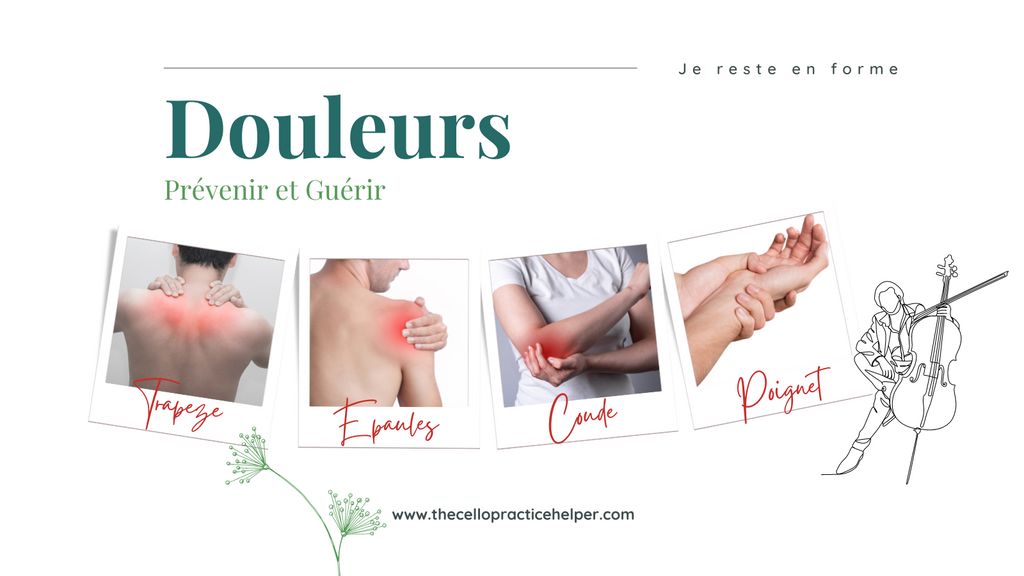Tendinites et Douleurs du Violoncelliste
Lorsque tu lis qu'un sportif de haut niveau est blessé, t'interroges-tu sur son talent ? Non! Malheureusement, parler de blessures ou de douleurs dans la musique classique est encore tabou. Brisons-le !
"Roger Federer withdraws from French Open due to knee injury concern" 1
"Rafael Nadal continues back injury rehab after Miami Open withdrawal" 2
Les coups d'archets, les mouvements de la main gauche et des doigts ont un mouvement mécanique, c'est pour cela que nos douleurs au violoncelle ont principalement une cause mécanique. Au cours de leurs études/carrière, la plupart des violoncellistes doivent faire face à des douleurs, des blessures ou un syndrome de surmenage, parlons-en...
.

Les principales causes
- manque de support de l'omoplate par le muscle serratus anterieur provocant ce que l'on appelle scapula winging en anglais, et créant des douleurs au trapèze ainsi que dans l'épaule, le coude ou le poignet.
- Coordination non optimale/faiblesse des muscles de l'épaule pendant le mouvement.
- Posture. La posture façonne votre corps pour créer les leviers dont vous avez besoin pour bouger et transmettre le poids du corps à vos cordes.
Alors comment prévenir ces douleurs?
- Ergothérapie
- Sophrologie
- Feldenkrais
- Qi Gong
- Hatha yoga (fait plus lentement que le yoga Vinyasa, les poses de Hatha yoga sont tenues plus longtemps, permettant plus d'étirements et de renforcement musculaire.
- échauffement avant de commencer à jouer
- apport alimentaire riche et sain
- boire de l'eau régulièrement - thé blanc +
- considérer un renforcement musculaire (gainage)
- en période intensive, se faire masser pour relâcher les muscles
- faire des pauses régulièrement
- légers étirements en coordination avec la respiration.
Les soigner en intégrant la biomécanique?
Je suis convaincue que l'intégration de biomécanique dans la pratique du violoncelle est un domaine clé dans le développement du jeu du violoncelliste. Les coups d'archets, les mouvements de la main gauche et des doigts ont un mouvement créé par des leviers, c'est pour cela que nos douleurs au violoncelle ont principalement une cause mécanique.
Mouvement optimal = Technique optimale
N'hésite pas à prendre rendez-vous et nous établirons ensemble un plan de travail.
:
Most common Tendinitis and tendonosis
- Lateral Epicondylitis Tendinitis & Tendinosis
- Medial Epicondylitis Tendinitis & Tendinosis
- Rotator Cuff Tendonitis & Tendinosis
Tendinitis VS tendinosis
Tendonitis and tendinosis share many of the same symptoms with the exception that tendinitis is often associated with redness, inflammation and swelling of the injured area, whereas tendinosis is not.*
Can it become chronic?
If you do not find the cause of the pain, yes.
When a tendinitis becomes chronic, there may be restriction of motion of the joint due to scarring or narrowing of the sheath of tissue that surrounds the tendon (see tendonosis below).
There is no "easy fix"but do not think you will lose time, it is the opposite! You will get a stronger technique and better sound after the healing a rehab process.
Why better sound and technique?
- how to use your muscles and articulation in an optimal way
- how to use the natural elasticity of your muscles
- how to transmit weight to the string without using too much strength
- How to use levers, body weight, string tension, and speed (for the bow)
- Left hand strength for demanding repertoire
- Fingers dexterity
- bow changes
- the volume of your sound (rich harmonics)
- bowing technique and sound at the tip of your bow.
Overuse syndrome or fatigue?
Overuse syndrome happens to professional cellists after an intensive and very demanding practice, recordings, competitions or performance activity. In the best case, it will go away with rest, a lot of water, diet, and good sleep. But be careful with tendinosis.
There is a common misconception that symptomatic tendon injuries are inflammatory; often are mislabeled as “tendinitis.*
.
What is a tendinosis?
Tendinosis is caused by chronic overuse of a tendon. The most common overuse tendinopathies in cellists involve the rotator cuff (shoulder joint), medial and lateral elbow epicondyles.
It can occur in cellists:
- who practice vigorously without enough rest in between practice sessions
- whose tendinitis is left untreated
- with a posture issue
- with tight calf muscles
Most patients with overuse tendinopathies (about 80 percent) fully recover within three to six months, and outpatient treatment should consist of relative rest of the affected area, icing, and eccentric strengthening exercises. Although topical and systemic nonsteroidal anti-inflammatory drugs are effective for acute pain relief, these cannot be recommended in favor of other analgesics. *
- resting the affected tendon
- taking a break every 15 minutes
- applying ice for 15 to 20 minutes, several times a day
- tape for support of the affected tendon
- performing light stretching exercises
- moving the affected area through its natural range of motion to prevent shortening of the related muscles and increase circulation
- physical therapy, posture work
- strength training
- massage
- nutrition, including vitamin C, manganese, and zinc for the synthesis of collagen production *
Healing
- physical therapy, posture work
- strength training
- resting the affected tendon
- taking a break every 15 minutes
- applying ice for 15 to 20 minutes, several times a day
- taping - for support of the affected tendon
- performing light stretching exercises
- moving the affected area through its natural range of motion to prevent shortening of the related muscles and increase circulation.
- massage
- nutrition, including vitamin C, manganese, and zinc for the synthesis of collagen production *
What is Collagen?
Collagen is a general term for structural proteins in the skin and connective tissue.
Food sources of collagen include the following:
Fish, Chicken, Egg whites, Citrus fruits, Berries, Red and yellow vegetables, Garlic, White tea, Leafy greens, Cashews, Tomatoes, Bell peppers, Beans, Avocados, Soy, Herbs high in collagen (Chinese knotweed, horsetail, gynostemma), Herbs that help to produce collagen (gotukola, bala, ashwagandha). *
"since collagen cannot be absorbed and is broken down into amino acids when consumed, the consumption of collagen does not guarantee that any new collagen will be made."
What about collagen supplements?
"Most collagen supplements undergo hydrolyzation to form hydrolyzed collagen that makes it easier to absorb and turn into tablets, capsules, and powders. Some supplements are infused foods that are drinks and/or edibles injected with collagen. Ingesting more than 20 grams per day may be harmful according to some dieticians."
Recovering from a tendinitis
Even though it was the tendon was inflamed, the true cause was the musculature. This is why you will have to re-educate.
Good posture puts the neck, head, shoulders, and thorax in the ideal position for muscular efficiency. It also ensures that the weight is distributed correctly and that the forces placed on each structure are tolerated.
It takes a lot of patience and observation but there is no alternative solution.

.
Recovering from a tendinitis
Even though it was the tendon was inflamed, the true cause was the musculature. This is why you will have to re-educate.
Good posture puts the neck, head, shoulders, and thorax in the ideal position for muscular efficiency. It also ensures that the weight is distributed correctly and that the forces placed on each structure are tolerated.
It takes a lot of patience and observation but there is no alternative solution.

References
- https://www.physio-pedia.com/Shoulder_Bursitis#cite_note-19
- Conduah, Augustine H., and Champ L. Baker. "Clinical management of scapulothoracic bursitis and the snapping scapula." Sports Health: A Multidisciplinary Approach 2.2 (2010): 147-155
- https://www.pthealth.ca/conditions/tendonitis-and-tendinosis/
- https://www.medicinenet.com/collagen_diet/article.htm
